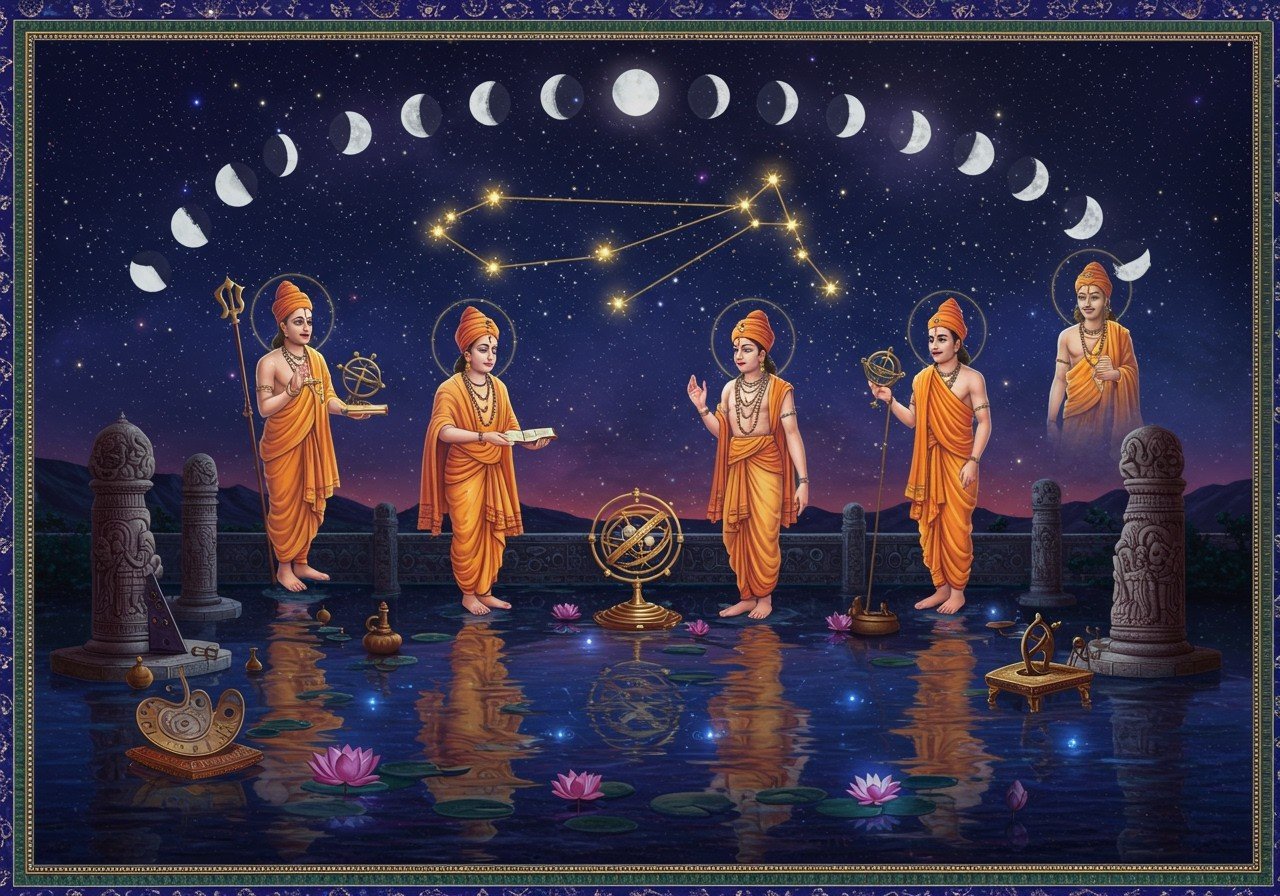
Embark on a celestial journey to explore the Saptarshi Mandal, a prominent star formation deeply rooted in Vedic astronomy and Indian culture. Known as Ursa Major or the Big Dipper in Western astronomy, this cluster holds profound significance. Discover its diverse interpretations across cultures, its influence on Indian traditions and astrology, and its connection to ancient Vedic texts.
Understanding Saptarshi Mandal
The Saptarshi Mandal, meaning “Seven Sages” in Sanskrit, comprises seven bright stars easily visible in the northern sky. These stars, including Dubhe and Merak, are prominently mentioned in Vedic texts, symbolizing guidance, wisdom, and divine inspiration in Hindu cosmology. Each star represents a revered sage, embodying profound spiritual understanding.
Ursa Major and the Big Dipper
Western astronomy identifies the Saptarshi Mandal as Ursa Major, the Great Bear constellation, one of the most recognizable celestial patterns. The Big Dipper, a prominent asterism within Ursa Major, has served as a navigational tool for centuries, guiding travelers and explorers. Interestingly, cultural interpretations of this star group vary significantly between Western astronomy and Vedic astrology.
Saptarshi Mandal in Vedic Astrology
In Vedic astrology, the Saptarshi Mandal plays a crucial role, influencing practices and beliefs. It’s linked to the Maha Yuga, the vast cosmic cycle of Hindu cosmology. The Mandal’s position is used to determine auspicious times, impacting individual horoscopes. It also connects with the Nakshatras, the lunar mansions of Vedic astrology, adding another layer of astrological significance.
Cultural Significance in Indian Traditions
Woven deeply into the fabric of Indian culture, the Saptarshi Mandal appears in various festivals and ceremonies, such as Navaratri and Mahashivratri. Ancient scriptures like the Rigveda and Mahabharata reference it as a symbol of eternal wisdom and cosmic order. Its influence extends to Indian art, literature, and folklore, enriching the cultural heritage for centuries.
Astronomical Insights
Scientifically, the Saptarshi Mandal offers valuable insights into astronomical studies. Located in the northern hemisphere’s night sky, Ursa Major’s visibility and distinct shape have made it a focal point for astronomers. Historically used for navigation by mariners, it continues to be studied today. Modern research focuses on the individual stars of the Saptarshi Mandal, analyzing their properties like distance, size, and spectral classifications.
For those interested in learning more about Yantras and Yagyas, Poojn.in offers a comprehensive guide: Yantras and Yagyas Explained: A Beginner’s Guide.
The Seven Sages and Their Stars
Each star in the Saptarshi Mandal is associated with a specific sage. Understanding these connections further deepens the cultural significance of this celestial formation. The pairings are as follows:
- Kratu: Represented by the star Dubhe (α Uma), Kratu is known for his wisdom and spiritual insight. He is often depicted as a sage with a deep understanding of cosmic laws.
- Pulaha: Associated with the star Merak (β Uma), Pulaha is considered a master of creative energy and artistic expression. He is associated with the creation of music and poetry.
- Pulastya: Linked to the star Phecda (γ Uma), Pulastya is revered for his knowledge of law and justice. He is often depicted as a sage who upholds righteousness and cosmic balance.
- Atri: Corresponding to the star Megrez (δ Uma), Atri is known for his fiery energy and spiritual power. He is associated with the element of fire and is considered a powerful force in the cosmos.
- Angiras: Represented by the star Alioth (ε Uma), Angiras is a sage associated with divine inspiration and spiritual awakening. He is often depicted as a guide for those seeking enlightenment.
- Vasishtha: Linked to the star Mizar (ζ Uma), Vasishtha is known for his wisdom and counsel. He is often depicted as a sage advising kings and rulers. Mizar is often paired with the nearby star Alcor, representing Arundhati, Vasishtha’s wife.
- Marichi: Associated with the star Alkaid (η Uma), Marichi is known for his radiant energy and spiritual brilliance. He is considered a source of light and guidance in the cosmos.
Delve deeper into the role of birth charts in Pooja practices with our insightful blog post: Understanding the Role of Birth Charts in Pooja Practices. This guide provides valuable information on how celestial alignments can influence your spiritual journey.
Poojn.in: Your Guide to Sacred Rituals
For those seeking to deepen their connection with the Saptarshi Mandal and incorporate its significance into their spiritual practices, Poojn.in offers a wide range of sacred items and resources. Explore our collection of authentic puja items, including:
- Sarbosadhi: This blend of sacred herbs is traditionally used in various rituals and ceremonies, enhancing the spiritual atmosphere and connecting you with divine energies.
- Five Mukhi Rudraksha Mala: This powerful mala is believed to enhance focus and concentration during meditation and spiritual practices, helping you connect with the divine wisdom of the Saptarshis.
- Kushal Mangal Kasturi Agarbatti: Create a sacred and serene atmosphere with these fragrant incense sticks, ideal for setting the mood for your spiritual practices. The Kasturi fragrance is known for its purifying properties.
- Learn about Rudraksha and Tulsi: Expand your knowledge of sacred Hindu symbols with our informative blog post on Rudraksha and Tulsi. Discover their significance and how they can be incorporated into your spiritual journey.
Embracing the Celestial Heritage
The Saptarshi Mandal continues to inspire awe and reverence, reflecting a timeless connection between the cosmos and human spirituality. It intertwines science, mythology, and astrology, creating a rich tapestry of cultural heritage. As we observe these seven celestial sages, we connect with the ancient wisdom they represent, bridging the past with the present. Embrace this celestial wonder through rituals, stargazing, or simply contemplation, and cherish our shared cosmic legacy.


